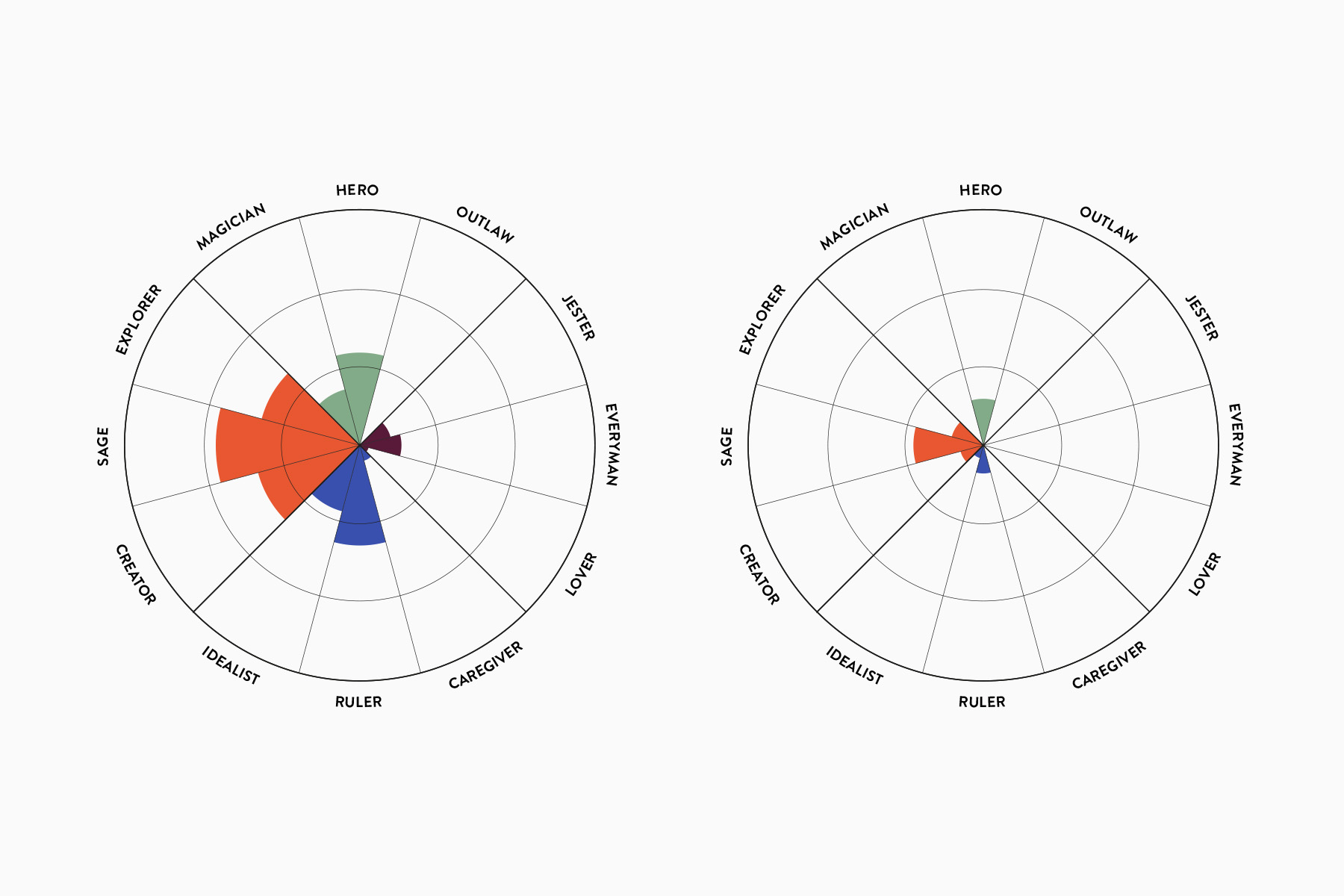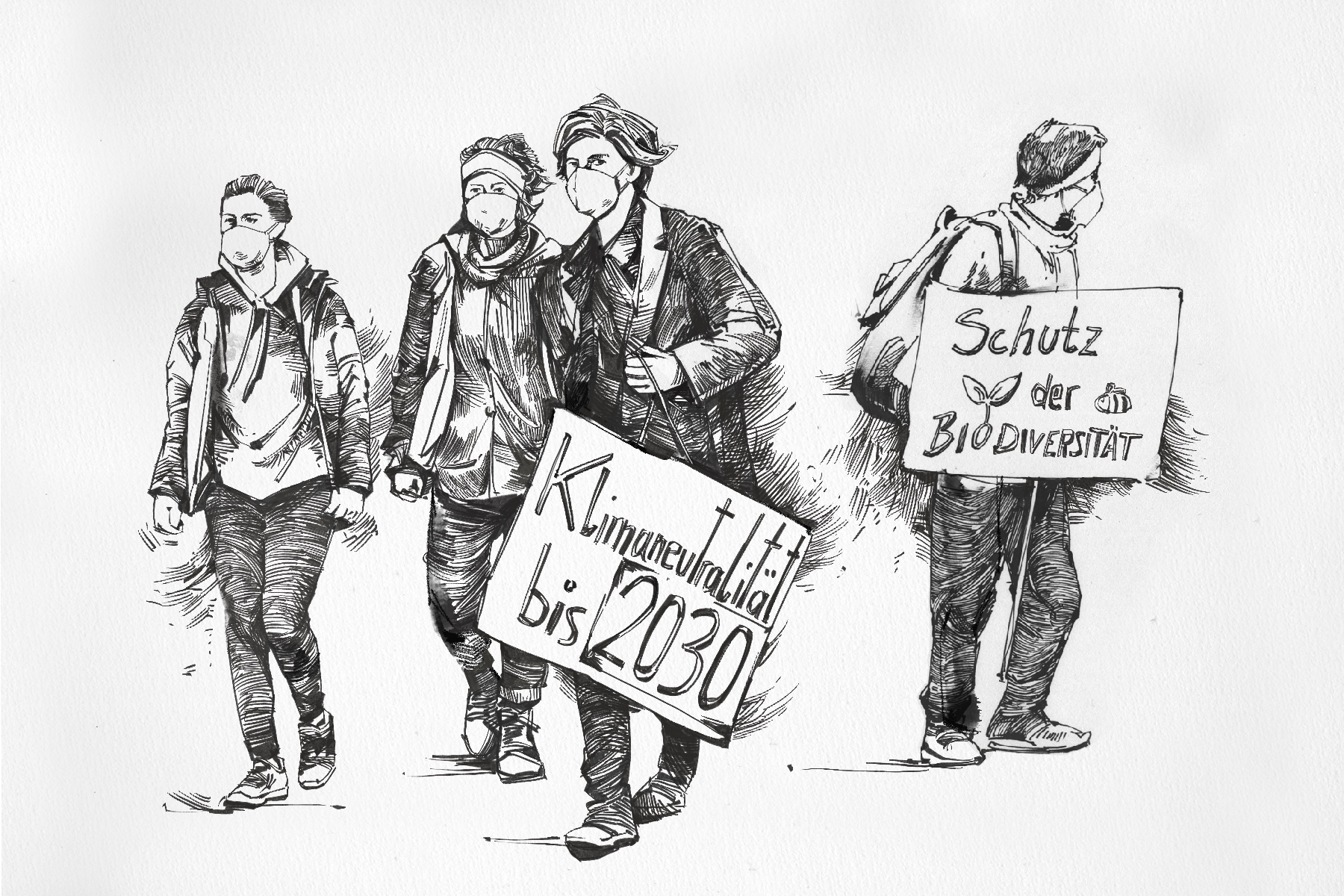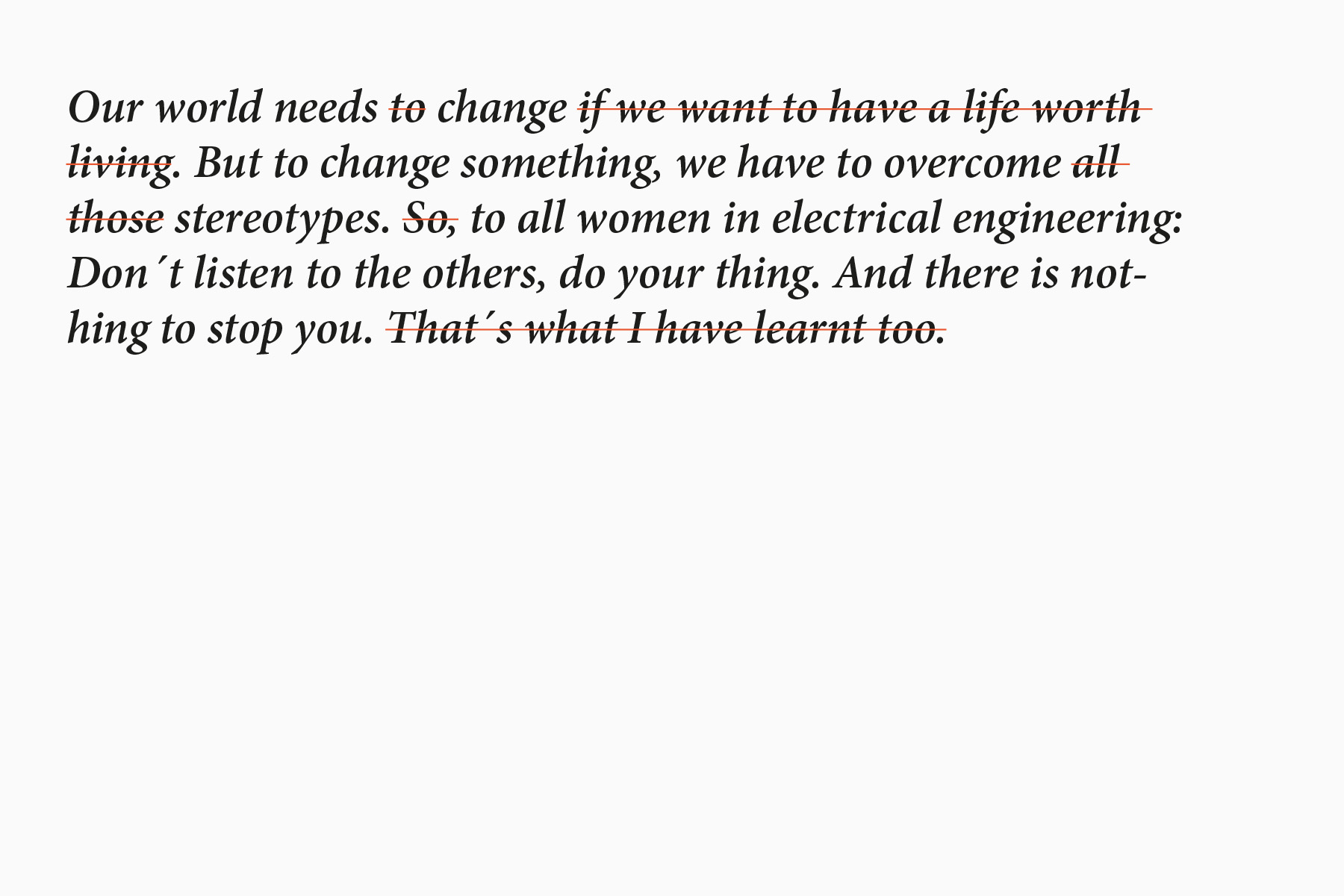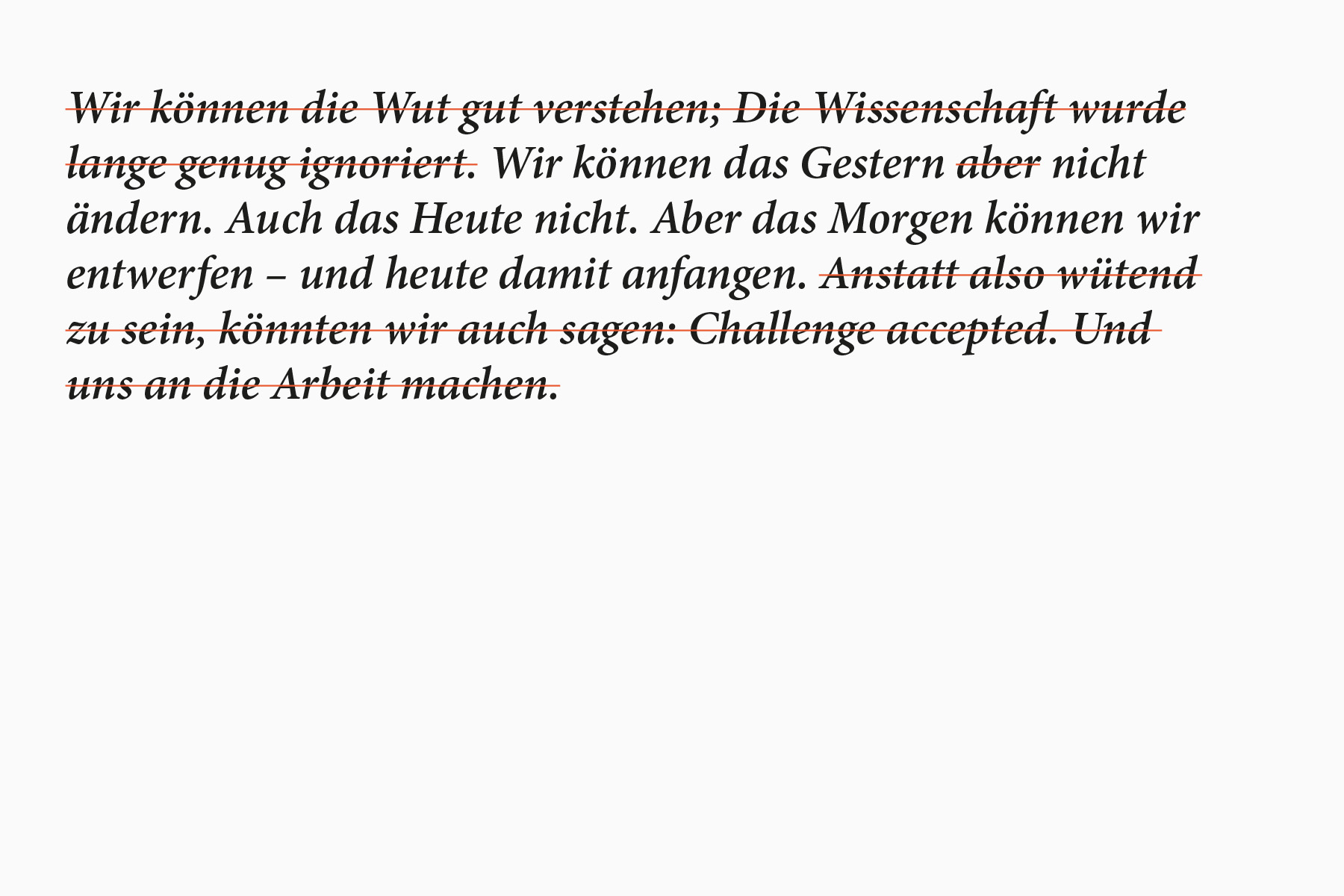
Be Part of the Equation
Brand Prototype
A proto-what? A brand prototype is an ambitious draft that is strategically developed with the client and finalised with a design team. The process ends after the design presentation and is usually carried on by the client or a third-party agency. The prototype therefore deliberately leaves out the question of realisation. And that’s a good thing: Because this question often comes too early in the process and stifles any wit and ambition that makes strong brands possible in the first place. A prototype thinks through ideas, messages, media and channels without any worries and works out a what-if – without the buts.
A Hesitant Beginning
I was commissioned to develop a design for the new communication line of ETIT – the Institute of Electrical Engineering at the Vienna University of Technology. The aim was to get more young people interested in the subject and thus increase the number of students.
To be honest, I turned it down at first, only to accept it a year later.
Why did I turn it down? Well, I thought I was the wrong person for the job.
I just couldn't see anything exciting in it. And how could I get others excited about something that left me completely cold? Only later did I realise that my image of electrical engineering was based on clichés. It was simply wrong.
Silvan Schmid, the deputy dean of the faculty, fortunately remained patient and followed up a year later. Flattered and a little embarrassed, I gave in. What Silvan doesn’t know is that his patience enabled me to embark on one of the more exciting expeditions in my career. And the confrontation with my own prejudice about the subject and profession quickly turned out to be a reflection of a social cliché that urgently needs to be corrected – especially in regard of our future.
After all, electrical engineering is not only highly creative, complex and transdisciplinary. It is everywhere, even if invisible, and forms the basis for technologies that make our everyday lives possible. And it is not only system-relevant for today: It plays a decisive role for the future of us all.
Electrical engineering offers practical approaches to perhaps the greatest challenge of our time: first and foremost, the success of the energy transition – a fundamental measure in the fight against climate change.
My interest was not just sparked after the first few conversations, it was wide awake. And it grew with every step I took in the project – along with an enthusiasm that I have rarely experienced.
The following case study looks at particular aspects of my work that I found the most exciting. Needless to say: It simplifies.

Die Online Befragung füllen 457 Studierende aus. Angehende Absolventen sehen das Studium kritischer, als die Erstsemester.
Grafik: Florian Hämmerle
Scratching the Surface
The project starts the usual way. In workshops I work with students on their personal view on studying. I learn about the challenges of the Bologna system. About a very intensive curriculum that has to be completed in a comparatively short time. I learn about the importance of theoretical principles – and that mathematics is the foundation and primary language of electrical engineering.
I learn about social images and individual dreams, fulfilled and unfulfilled expectations. About the difference in depth and quality compared to universities of applied sciences, about the “fancy names” that make electrical engineering more attractive there and perhaps explain the influx of students. About later roles in professional life, job offers in the midst of studies, research topics and the dynamic between students and lecturers.
The discussion is surprisingly emotional and full of energy. And even after the workshop, we stay together for a while and discuss – the students want to be heard. I'm starting to get tired – too much input – but I also realize, I am only scratching the surface.
In discussions with lecturers, I want to delve deeper and ask questions about so many topics. I get to know exciting perspectives and attitudes. My image of electrical engineering is crumbling.
We talk, for example, about the transformation of our society and what the world of tomorrow might look like. About the key role of electrical engineering in digitalisation, telecommunications, automation, e-mobility, climate change, robotics and sensor technology. About sustainable energies that generate electricity. About the generation, storage, distribution and conversion of energy.
About projects, start-ups and patents that could one day change the world. On a large and small scale. About the central tasks of a university – research and teaching – and why they are not always easy to combine. About image-damaging stereotypes and role models – “coil winders” and “circuit board solderers” – and the urgent need for clarification. About women in technology and the challenges they face. About cooperation with industry and the social role of science. About basic research and education as self-empowerment. And about the concerns of an entire generation who, in their powerlessness, have taken to the streets.
The complexity overwhelms me – despite the fascination it arouses in me.
But much more important is a realisation that literally forces itself upon me: It is no wonder that the Institute has a hard time explaining its content to the masses – especially to young high-school students who have no idea what electrical engineering is, or at least have the wrong idea. The subject is just too complex.
However, when I remark that the communication needs to be simplified, I am met with skepticism –from students and lecturers alike. After all, science is complex, whereas brands stay as simple as possible.
A contradiction?
The struggles of a young generation
Together with a small team of students, we define the target groups to be reached. We look for overlaps – between what the studies offer young people and their real needs. I’m particularly interested in two aspects that emerged from the interviews: feeling powerless. And education as self-empowerment.
During my preparation, I stumble upon a large number of studies on Generation Z, the current high school graduates. A 2019 survey looks at how the younger generation sees itself and its future, and delivers shocking results: 61% of 18- to 24-year-olds believe they are paying for the mistakes of older generations. 68% think the world is harder for them, and a whopping 71% feel their concerns are misunderstood or even dismissed.
Climate change threatens our environment, a war rages in Europe, an epidemic isolates young people in the middle of a critical phase of their development. A climate of fear leaves its mark, especially on the psyche of a generation lacking solid experience.
When the world seems uncertain, the desire for security is a key criterion in many decisions – for example, in the choice of a career and, consequently, a course of study. And even the excessive consumption of digital media – which according to studies exceeds two full days a week – and the rejection of traditional information media such as newspapers, magazines, or even television becomes comprehensible against this background:
The virtual world tempts with comparatively simple rules. Unwanted (often frightening) information only enters my bubble if I really want it to.
So it is hardly surprising when experts draw a parallel with another development: suicidal tendencies among young people are increasing rapidly, as is the number of serious mental illnesses such as depression, anxiety and personality disorders.
So much for powerlessness.
That hurts.

The challenges of a generation in one picture.
Illustration: Maria Savko
Education as self-empowerment
Through those studies, I identify two anchors of effective communication – resonance and relevance. These two concepts are easy to outline: Communication that takes another person’s needs seriously automatically makes itself heard – the basic principle of resonance. Communication that offers solutions to others’ concerns creates relevance – both factual and emotional.
Great brands are aware of these effects. And they know how to use and exploit them.
But rarely do substance and message come together in such a convincing way as they do at a university. Studying electrical engineering can satisfy the young generation’s need for safety on several levels: As a guarantee of a well-paid job – TU graduates can literally choose their employer. And as an opportunity to help create a better world for them, to find solutions to the major changes facing our societies.
With knowledge comes a sense of control. Studying provides the tools to shape your future, not be at its mercy.
The student becomes a variable in an unsolved equation: future.
I like this image.
This also defines the core message of the brand design, around which I organize the content, and I decide to expand the team. I also want to convey the message visually – and as a rusty graphic designer, I need help if I don’t want to fail by my own standards.

The imagery is based on ETITs main areas of focus.
Design: rawty.co
Be part of the equation
It was not particularly difficult to get the Graz-based design agency RAWTY interested in the project. The young team around Tessa Huber, Sophia Stöhr and Christian Leban wants to use their skills to make a difference. They call it Purpose Driven Design – and this project and my thoughts come at just the right time.
So we got to work. We wanted to develop a joint image that would give prospective students a sense of control over their own future. It should connect to the big issues of the future that concern the younger generation and for which the studies can provide solutions.
At the same time, the design system should remain flexible enough not only to attract attention, but also to create trust. This also requires work on the content: Events, infographics, news, research projects, start-ups and quotes from students and lecturers round off the portrait of the faculty. These are grouped into topic clusters for the social media channels on which the target group is primarily active. Targeting should be handled by a performance marketing agency.
In less than three weeks, rawty surprised me with an ambitious idea that took my approach one step further: they visually translated the claim "be part of the equation" into a slogan system.
A simple equation transforms a person and the knowledge acquired during their studies into a solution for the future.
The system is surprisingly simple and uses stylistic patterns from mathematics, the theoretical basis of electrical engineering. The result of the equation can be adapted to the core themes of the faculty, but also to the needs of the target groups.
The messages are conveyed through a new brand design: RAWTY reduces the logo to the name of the faculty and creates an animated, illustrated world that speaks to the core themes while presenting a positive vision of a future powered by technology. A bold neon yellow makes the brand stand out from the usual blue-gray of other faculties and complements the TU Vienna’s more subdued color palette.
Together with the elaborated strategy, its derivation, the resulting focal points, texts and quotes and a comprehensive design draft by RAWTY, we hold a presentation. And present the prototype to a committee of faculty. The design is convincing, approved by the institute, further developed internally at the TU and – as far as we know – largely implemented.

The formulas are used to create a design system adressing young people on social media.
Design: rawty.co
I am still learning
In my presentations, I always preach that every company, every topic has something special about it. And that our task is to find that and translate it into a language. In this project, however, I wasn’t true to this idea, otherwise I wouldn’t have hesitated for so long.
In fact, it was almost cynical: The projects I took on instead, seemed to interest me more, but quickly left me underchallanged. This project showed me that the really valuable learning moments are still outside my comfort zone. And that growth requires courage.
The project also marked the beginning of a collaboration with a design team that is not only versatile in terms of brand design, illustration, UX/UI and animation, but can also think strategically. The way RAWTY translated the complex project into a seemingly simple language still inspires me today. In doing so, they provided the necessary impetus to clarify the question of whether brand and substance do not necessarily have to be contradictory – especially in the context of scientific work.
One of the tasks of our universities is the transfer of knowledge. To this end, knowledge must also be translated for the layperson, i.e. simplified and thus made accessible. Otherwise, its value for society remains hidden and universities appear "elitist", which also puts many young people off.
Thanks to RAWTY’s translation of the message into formulas, the design remains precise and clever in its statements – despite the strong simplification.
The result is a creative freedom is not only unconventional and quite unique, but it also does not wear out. And it gives the Faculty the opportunity to adapt its messages to new target groups or topics with relatively little effort – even in the years to come.
You can learn more about the design project and the same case from RAWTY’s point of view, their thought processes and visual results on their website.
Made by David.

Florian Hämmerle
Strategy
Claim
Copywriting

Tessa Huber
Design Strategy
Brand Design
rawty.co

Christian Leban
Design Strategy
Illustration
rawty.co

Sophia Stöhr
Design Strategy
Animation Design
rawty.co




